State Railway of Thailand
 | |
 | |
| Locale | Thailand |
|---|---|
| Dates of operation | 1890–present |
| Track gauge | 1,000 mm (3 ft 3 3⁄8 in) meter gauge |
| Previous gauge | 1,435 mm (4 ft 8 1⁄2 in) standard gauge |
| Length | 4,070 km (2,530 mi) |
| Headquarters | Bangkok |
The State Railway of Thailand (SRT) (Thai: การรถไฟแห่งประเทศไทย) is the state-owned rail operator in Thailand. The network serves around 44 million passengers per year (2014).[1]
History
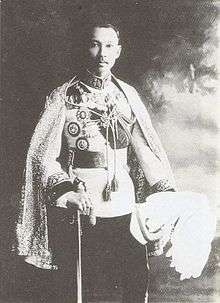
The SRT was founded as the Royal State Railways of Siam (RSR) in 1890. King Chulalongkorn ordered the Department of Railways to be set up under the Department of Public Works and Town and Country Planning. Construction of the Bangkok-Ayutthaya railway (71 km or 44 mi), the first part of the Northern Line, was started in 1890 and inaugurated on 26 March 1896.[2] The Thonburi-Phetchaburi line (150 km or 93 mi), later the Southern Line, was opened on 19 June 1903. The first railway commander of the RSR was Prince Purachatra Jayakara (Krom Phra Kamphaeng Phet Akkarayothin)
The Northern Line was originally built as 1,435 mm (4 ft 8 1⁄2 in) standard gauge , but in September 1919 it was decided to standardize on 1,000 mm (3 ft 3 3⁄8 in) meter gauge and the Northern Line was regauged during the next ten years. On 1 July 1951, RSR changed its name to the present State Railway of Thailand.[2]
In 2014 SRT had 4,043 km (2,512 mi) of track, all of it meter gauge Nearly all is single-track (3,685 km), although some important sections around Bangkok are double (251 km or 156 mi) or triple-tracked (107 km or 66 mi) and there are plans to extend this.[3]
Issues

The SRT has long been popularly perceived by the public as inefficient and resistant to change. Trains are usually late, and most of its equipment is old and poorly maintained. The worst financially performing state enterprise, the SRT consistently operates at a loss despite being endowed with large amounts of property and receiving large government budgets. It reported a preliminary loss of 7.58 billion baht in 2010.[4] Recurring government attempts at restructuring and/or privatization throughout the 2000s have always been strongly opposed by the union and have not made any progress.[5][6]
SRT's failings are reflected in passenger numbers, which have dropped from 88 million in 1994 to 44 million in 2014.[1]
The Thai rail network has 2,624 level crossings nationwide (2016). Many have no crossing barriers, making them common and frequent sites of accidents.[7]
Only two percent of Thailand's freight is transported by rail, despite rail being roughly half the cost of road transport and cleaner environmentally.[8]
Network

The SRT operates all of Thailand's national rail lines. Bangkok Railway Station (Hua Lamphong Station) is the main terminus of all routes. Phahonyothin and ICD Ladkrabang are the main freight terminals.
Northern Line
The Northern Line runs alongside the Northeastern Line until the Ban Phachi Junction. There, it splits from the Northeastern Line and proceeds through Lopburi, Nakhon Sawan, Phichit, Phitsanulok, Denchai, Lampang, Lamphun, before finally reaching Chiang Mai, 751 km from Bangkok. There is also a branch off the mainline from Ban Dara Junction to Sawankhalok in Sukhothai Province.
- Bang Sue Junction - The largest freight yard in Thailand and hence the Phahonyothin main freight terminal. There is also a locomotive depot.
- Ayutthaya Station - Northern Bangkok suburban station. High passenger revenue, second only to Bangkok Station. It is possible to change here to the Northeastern Line.
- Ban Phachi Junction - A major junction, where the Northern and Northeastern lines separate.
- Lopburi Station - The end of northern Bangkok suburban service; a military town with lots of history.
- Nakhon Sawan Station - Nakhon Sawan Main Station, Nong Pling Station until 1956.
- Phichit Station- Phichit Main Station
- Phitsanulok Station - Phitsanulok Main station, town with the famous Phra Phuttha Chinnarat
- Ban Dara Junction - Junction for Sawankhalok Line
- Sawankhalok Station- Terminus of Sawankhalok Branch. Station for Sukhothai Province and travel to Sukhothai and Si Satchanalai Historical Parks.
- Uttaradit Station - Main station, Uttaradit Province.
- Sila At Station - Depot on the Northern Line. Refueling station and up trains will be cut at this station
- Den Chai Station - the dropping point for Phrae with a proposal for a junction for Den Chai – Chiang Rai route
- Nakhon Lampang Station - Depot on the Northern Line. Train will be cut further if going north to Chiang Mai.
- Khun Tan Station- Station in the mountains, base point and entrance for Doi Khuntan National Park. Railway bungalows also here
- Lamphun Station - Main station for Lamphun Province
- Chiang Mai Station - Northern terminus.
Northeastern Line
The Northeastern Line begins on the same route as the Northern Line, splitting at Ban Phachi Junction towards Nakhon Ratchasima. Then at Thanon Chira Junction, the line splits with one route passing Khon Kaen and Udon Thani before terminating at Nong Khai 624 kilometers from Bangkok. The other route passes through Buriram, Surin, Sisaket to reach Ubon Ratchathani, 575 km from Bangkok.
There is also another branch route originating from Kaeng Khoi Junction in Saraburi Province passing through Chai Badan District in Lopburi Province and Chatturat District in Chaiyaphum Province, before joining the mainline heading towards Nong Khai at Bua Yai Junction in Nakhon Ratchasima Province.
- Saraburi Station - Main Saraburi station, named Pak Priaw station until 1934.
- Kaeng Khoi Junction - The Bua Yai Line and Khlong Sip Kao line diverge from the mainline here. Main Depot with refuelling facility. The point for dividing freight trains into two trains to pass difficult section of Dong Phraya Yen (Kaeng Khoi - Pak Chong) or combining divided freight trains into one train
- Pak Chong Station - The gateway to Nakhon Ratchasima and the point for dividing freight trains into two to pass difficult section of Dong Phraya Yen (Kaeng Khoi - Pak Chong) or combining divided freight trains into one train
- Nakhon Ratchasima Station - Main depot of the Northeastern Line with refuelling facility and a branch line to 2nd Army Support Command. Main Nakhon Ratchasima station.
- Thanon Chira Junction - Junction for Nong Khai line close to Fort Suranaree (2nd Army Region HQ)
- Buriram Station - Buriram provincial station with a branch line to a quarry at Khao Kradong
- Surin Station - Main Surin station
- Si Sa Ket Station - Main Sisaket station.
- Ubon Ratchathani Station in town of Warin Chamrap - Terminus of South Isaan Line (also known as Ubon Line) with depot and refuelling facility. Named Varindr station until 1942-1943. Main Ubon Ratchathani Station.
- Lam Narai Station- Station on the Lam Narai/Bua Yai Branch, for Chai Badan Municipality.
- Chatturat Station- Station on the Lam Narai/Bua Yai Branch, alight for Chaiyaphum.
- Bua Yai Junction - junction with refuelling facility
- Khon Kaen Station - Khon Kaen main station
- Udon Thani Station - Udon Thani main station with refuelling facility.
- Nong Khai Station in town of Nong Khai - Terminus of North Isaan Line (also known as Nong Khai Line), provides a connection to Thanaleng Station in Vientiane, Laos. Main Nong Khai station.
Southern Line

The Southern Line begins in Bangkok and heads west towards Nakhon Pathom before splitting into three different routes. One route heads west to Kanchanaburi Province (210 km) while another heads north towards Suphan Buri (157 km). The Southern Line itself continues southbound through Ratchaburi, Phetchaburi, Hua Hin, Prachuap Khiri Khan Province, Chumphon, to Surat Thani 678 kilometers distant. From Surat Thani, there is a westerly branch towards Khiri Rat Nikhom while the main line continues south to Thung Song Junction in Nakhon Si Thammarat Province where another branch reaches Kantang in Trang Province. Not far away, another branch separates off the mainline at Khao Chum Thong Junction. The main line from Nakhon Sri Thammarat continues through Phatthalung before reaching Hat Yai Junction in Songkhla Province. From here, a line branches to connect with the Malaysian railway at Padang Besar and the mainline continues to Su-ngai Kolok passing through Yala Province.
- Bang Sue Junction - Main junction and freight terminal with main diesel locomotive depot and refuelling facility
- Bang Bamru Station- Suburban Station, all trains must stop here. First station after crossing the Rama 6 Bridge from Bang Sue.
- Taling Chan Junction- Junction for Southern Main Line(Bang Sue-Taling Chan Link) and Thonburi Branch.
- Thon Buri Station - Former terminus of Southern Line, however some southern trains remain to start the journey here.
- Salaya Station- Suburban Station, for Phutthamonthon District and Mahidol University (Salaya Campus)
- Nakhon Pathom Station - Main southern suburban station. Main Nakhon Pathom station.
- Nong Pladuk Junction - Junction for Namtok Branch Line and Suphan Buri Branch Line.
- Ban Pong Station - Interchange to Kanchanaburi for those who did not travel along Nam Tok branch line
- Ratchaburi Station - Terminal for southern suburban service, also Ratchaburi main station.
- Phetchaburi Station - Phetchaburi main station.
- Hua Hin Station - Provincial Station for Hua Hin in Prachuap Khiri Khan with crew changing station.
- Wang Phong Station- One of the stations in Pran Buri. Also for the nearby Thanarat Military Camp. More trains stop here for Pran Buri than Pran Buri Station itself.
- Pran Buri Station- Smaller station for Pran Buri, with a well-established Saturday Night Market opposite the station.
- Prachuap Khiri Khan Station - Prachuap Khiri Khan main station.
- Bang Saphan Yai Station - Regional town station. All trains going further south must stop here.
- Chumphon Station - Main Chumphon station, locomotive depot with refuelling facility
- Lang Suan Station- Provincial Station in Chumphon. Furthest extent of southern services from Thonburi.
- Ban Thung Pho Junction - Southern container yard, for Khiri Rat Nikhom Branch.
- Khiri Rat Nikhom Station - Terminus for the Khiri Rat Nikhom Branch and the railway to Phang Nga and Tanun (Phuket).
- Surat Thani Station - Crew changing station and Surat Thani main station.
- Thung Song Junction - Locomotive depot, refuelling facility and junction for Kantang Branch.
- Trang Station - Trang main station.
- Kantang Station - Terminus of Kantang Branch.
- Khao Chum Thong Junction - Junction for Nakhon Si Thammarat Branch.
- Nakhon Si Thammarat Station - Terminus of Nakhon Si Thammarat Branch. Nakhon Si Thammarat main station.
- Phatthalung Station - Phatthalung main station, crew changing station
- Hat Yai Junction - Main junction for Malaysia and Singapore and Main Line of Southern Line, Locomotive Depot and refuelling facility. Main Songkhla Station.
- Padang Besar Station - International KTM station in Malaysia. Trains continue to Butterworth (Penang) and further.
- Pattani Station - formerly Khok Pho station, Pattani main station.
- Yala Station - Main Yala station, crew changing station
- Tanyong Mat Station - for Ra Ngae district and Narathiwat.
- Su-ngai Kolok Station - Terminus of Southern Line. Used to be an international station until the termination of cross border services.
Namtok Branch
Burma Railway | ||||||||||||||||||||||||||||||||||||||||||||||||||||||||||||||||||||||||||||||||||||||||||||||||||||||||||||||||||||||||||||||||||||||||||||||||||||||||||||||||||||||||||||||||||||||||||||||||||||||||||||||||||||||||||||||||||||||||||||||||||||||||||||||||||||||||||||||||||||||||||||||||||||||||||||||||||||||||||||||||||||||||||||||||||||||||||||||||||||||||||||||||||||||||||||||||||||||||||||||||||||||
|---|---|---|---|---|---|---|---|---|---|---|---|---|---|---|---|---|---|---|---|---|---|---|---|---|---|---|---|---|---|---|---|---|---|---|---|---|---|---|---|---|---|---|---|---|---|---|---|---|---|---|---|---|---|---|---|---|---|---|---|---|---|---|---|---|---|---|---|---|---|---|---|---|---|---|---|---|---|---|---|---|---|---|---|---|---|---|---|---|---|---|---|---|---|---|---|---|---|---|---|---|---|---|---|---|---|---|---|---|---|---|---|---|---|---|---|---|---|---|---|---|---|---|---|---|---|---|---|---|---|---|---|---|---|---|---|---|---|---|---|---|---|---|---|---|---|---|---|---|---|---|---|---|---|---|---|---|---|---|---|---|---|---|---|---|---|---|---|---|---|---|---|---|---|---|---|---|---|---|---|---|---|---|---|---|---|---|---|---|---|---|---|---|---|---|---|---|---|---|---|---|---|---|---|---|---|---|---|---|---|---|---|---|---|---|---|---|---|---|---|---|---|---|---|---|---|---|---|---|---|---|---|---|---|---|---|---|---|---|---|---|---|---|---|---|---|---|---|---|---|---|---|---|---|---|---|---|---|---|---|---|---|---|---|---|---|---|---|---|---|---|---|---|---|---|---|---|---|---|---|---|---|---|---|---|---|---|---|---|---|---|---|---|---|---|---|---|---|---|---|---|---|---|---|---|---|---|---|---|---|---|---|---|---|---|---|---|---|---|---|---|---|---|---|---|---|---|---|---|---|---|---|---|---|---|---|---|---|---|---|---|---|---|---|---|---|---|---|---|---|---|---|---|---|---|---|---|---|---|---|---|---|---|---|---|---|---|---|---|---|---|---|---|---|---|---|---|---|---|---|---|---|---|---|---|---|---|---|---|---|---|---|---|---|---|---|---|---|---|---|---|---|---|---|---|---|---|
Legend
| ||||||||||||||||||||||||||||||||||||||||||||||||||||||||||||||||||||||||||||||||||||||||||||||||||||||||||||||||||||||||||||||||||||||||||||||||||||||||||||||||||||||||||||||||||||||||||||||||||||||||||||||||||||||||||||||||||||||||||||||||||||||||||||||||||||||||||||||||||||||||||||||||||||||||||||||||||||||||||||||||||||||||||||||||||||||||||||||||||||||||||||||||||||||||||||||||||||||||||||||||||||||
- Thon Buri Station - Terminus of Western Line
- Taling Chan Junction - Junction for Bangsue - Taling Chan link (also known as Rama 6 Line), the connection between south and north SRT systems opened with the building of the only rail bridge across the Chao Phraya River in 1925.
- Salaya Station - Bangkok suburban station close to Mahidol University (Salaya Campus)
- Nakhon Pathom Station - Nakhon Pathom main station.
- Nong Pladuk Junction - Junction for Suphan Buri and Kanchanaburi.
- Suphanburi Station - A 2-car DMU operates to Bangkok in the early morning and from Bangkok in the evening.
- Kanchanaburi Station - Main Kanchanaburi station
- Nam Tok Station - Terminus of Western Line.
Eastern Line
The Eastern Line begins at Bangkok before heading through Chacheongsao, Prachinburi to terminate at Aranyaprathet in Sa Kaew Province, 255 kilometers from Bangkok. There is an unused rail link to Cambodia from Aranyaprathet, currently being rebuilt. A branch line also connects Khlong Sip Kao Junction to the Northeastern Line at Kaeng Khoi Junction. At Chachoengsao Junction, there is another branch to Sattahip. Along the route to Sattahip, at Si Racha Junction, there is yet another branch towards Laem Chabang Deep Sea Port and further at Khao Chi Chan Junction for Map Ta Phut Port, in Rayong.
- Makkasan Station - the main depot of SRT (Makkasan Works)
- Hua Mak Station - Bangkok suburban station
- Hua Takhe Station - Junction for ICD.
- Chachoengsao Junction - Junction for Laem Chabang (double track opened January 2012[9]) and Aranyaprathet Line. Main Chachoengsao station.
- Khlong Sip Kao Junction- Junction for the Aranyaprathet Line and the Cargo Link to Kaeng Khoi Junction.
- Prachin Buri Station- Main Prachin Buri Province Rail Station.
- Kabin Buri Station- Half of long-distance Aranyaprathet Line services terminate here. In Prachin Buri Province.
- Sa Kaeo Station - Main Sa Kaeo station
- Aranyaprathet Station - Terminus of Aranyaprathet Main Line.
- Chonburi Station- Main Chonburi station
- Si Racha Junction - Junction for Laem Chabang Deep Sea Port.
- Pattaya Station - Railway station for Pattaya City.
- Khao Chi Chan Junction- Junction for Sattahip Commercial Port and Map Taphut Freight Line
- Ban Phlu Ta Luang Station -Terminus for current, operational, ordinary train from Bangkok.
- Map Ta Phut Station - Terminus of East Coast Line - freight trains only.
Maeklong Line
Maeklong Railway | |||||||||||||||||||||||||||||||||||||||||||||||||||||||||||||||||||||||||||||||||||||||||||||||||||||||||||||||||||||||||||||||||||||||||||||||||||||||||||||||||||||||||||||||||||||||||||||||||||||||||||||||||||||||||||||||||||||||||||||||||||||||||||||||||||||||||||||||||||||||||||||||
|---|---|---|---|---|---|---|---|---|---|---|---|---|---|---|---|---|---|---|---|---|---|---|---|---|---|---|---|---|---|---|---|---|---|---|---|---|---|---|---|---|---|---|---|---|---|---|---|---|---|---|---|---|---|---|---|---|---|---|---|---|---|---|---|---|---|---|---|---|---|---|---|---|---|---|---|---|---|---|---|---|---|---|---|---|---|---|---|---|---|---|---|---|---|---|---|---|---|---|---|---|---|---|---|---|---|---|---|---|---|---|---|---|---|---|---|---|---|---|---|---|---|---|---|---|---|---|---|---|---|---|---|---|---|---|---|---|---|---|---|---|---|---|---|---|---|---|---|---|---|---|---|---|---|---|---|---|---|---|---|---|---|---|---|---|---|---|---|---|---|---|---|---|---|---|---|---|---|---|---|---|---|---|---|---|---|---|---|---|---|---|---|---|---|---|---|---|---|---|---|---|---|---|---|---|---|---|---|---|---|---|---|---|---|---|---|---|---|---|---|---|---|---|---|---|---|---|---|---|---|---|---|---|---|---|---|---|---|---|---|---|---|---|---|---|---|---|---|---|---|---|---|---|---|---|---|---|---|---|---|---|---|---|---|---|---|---|---|---|---|---|---|---|---|---|---|---|---|---|---|---|---|---|---|---|---|---|---|
Legend | |||||||||||||||||||||||||||||||||||||||||||||||||||||||||||||||||||||||||||||||||||||||||||||||||||||||||||||||||||||||||||||||||||||||||||||||||||||||||||||||||||||||||||||||||||||||||||||||||||||||||||||||||||||||||||||||||||||||||||||||||||||||||||||||||||||||||||||||||||||||||||||||
| |||||||||||||||||||||||||||||||||||||||||||||||||||||||||||||||||||||||||||||||||||||||||||||||||||||||||||||||||||||||||||||||||||||||||||||||||||||||||||||||||||||||||||||||||||||||||||||||||||||||||||||||||||||||||||||||||||||||||||||||||||||||||||||||||||||||||||||||||||||||||||||||
The Maeklong Railway, also operated by the SRT, is independent of the national rail network and is split into two sections. The line begins at Wongwian Yai in Bangkok before terminating at Mahachai where a ferry is used by passengers to cross the Tha Chin River. The line starts again across the river at Ban Laem and continues towards Mae Klong.[10]
Services
Intercity services
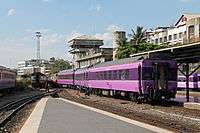
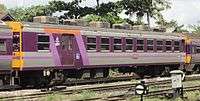
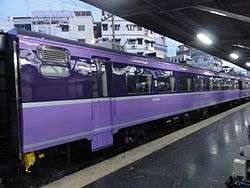
SRT operates intercity passenger services on the following lines:
Northern Line
Northeastern Line
- Bangkok-Ayutthaya-Saraburi-Nakhon Ratchasima-Khon Kaen-Udon Thani-Nong Khai
- Bangkok-Ayutthaya-Saraburi-Nakhon Ratchasima-Buriram-Surin-Sisaket-Ubon Ratchathani
Eastern Line
- Bangkok-Chachoengsao-Prachinburi-Kabin Buri-Sa Kaeo-Aranyaprathet
- Bangkok-Chachoengsao-Chonburi-Pattaya-Ban Phlu Ta Luang
Southern Line
- Bangkok-Nakhon Pathom-Hua Hin-Surat Thani-Hat Yai-Butterworth (Malaysia)(International Express)
- Bangkok-Nakhon Pathom-Hua Hin-Surat Thani-Hat Yai-Su-ngai Kolok
- Bangkok-Nakhon Pathom-Hua Hin-Surat Thani-Thung Song-Nakhon Si Thammarat
- Bangkok-Nakhon Pathom-Hua Hin-Surat Thani-Thung Song-Kantang
- Bangkok-Nakhon Pathom-Kanchanaburi-Nam Tok
International services
SRT operates international services to Butterworth in Penang, Malaysia, in conjunction with Malaysian state operator KTM.
A link across the First Thai–Lao Friendship Bridge to Thanaleng Railway Station, near Vientiane, opened in March 2009.[11]
There are plans to re-open rail links to Cambodia via Poipet from the railhead at Aranyaprathet. Railway connections to Myanmar (Burma), notably the infamous Death Railway, are defunct.
In December 2010, following Chinese plans to extend their (standard gauge) network to Xishuangbanna on the China-Laos border and further into Laos,[12] the Thai government agreed to start negotiations on building a standard-gauge network.[13] This would initially involve two lines: from Bangkok to the Lao border, and a longer line from Bangkok along the peninsula to the Malay border.[14]
SRT also allows operation of the Eastern and Oriental Express on their tracks which runs from Singapore to Bangkok and vice versa, with a few trips to Laos and Chiang Mai.
Rail links to adjacent countries
-
 Malaysia - same 1,000 mm (3 ft 3 3⁄8 in) gauge
Malaysia - same 1,000 mm (3 ft 3 3⁄8 in) gauge -
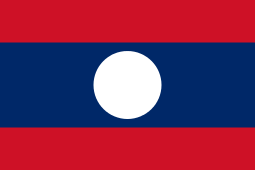 Laos - same 1,000 mm (3 ft 3 3⁄8 in) gauge across Mekong River on Thai-Lao Friendship Bridge
Laos - same 1,000 mm (3 ft 3 3⁄8 in) gauge across Mekong River on Thai-Lao Friendship Bridge -
 Cambodia - disused (being rebuilt)
Cambodia - disused (being rebuilt) -
 Myanmar - defunct (see Death Railway). But projected extension will rebuild the route.[15]
Myanmar - defunct (see Death Railway). But projected extension will rebuild the route.[15]
Commuter trains
The SRT operates commuter rail services from Bangkok along the Northern and Northeastern Lines up to Ayutthaya, Ban Phachi Junction, Lopburi and Kaeng Khoi Junction. Ten trains run along the route on a daily basis.[16] A new service serving between Thonburi and Sala Ya was launched on 22 October 2010.[17]
The Red Line project is a new commuter rail system also owned by the SRT. It is currently under construction and will replace portions of rail lines running through Bangkok, eliminating at-grade crossings.
Other passenger services
SRT operates the Airport Link to Suvarnabhumi Airport which opened in 2010.[18] It is medium speed (160 km/h) and links with BTS Skytrain at Phaya Thai Station and MRT at Phetchaburi Station, and a new transit center at Makkasan allows airline passengers to check-in.
Freight
Thai railways transported around 11 million tons of freight per year in 2007-2012, which was around 2% of the total amount of freight moved by all modes of transportation.[19] While it is possible for freight trains to travel between Thailand and the neighboring countries (Malaysia and Laos), the amount of international rail freight presently constitutes only a minuscule portion of Thailand's foreign trade. In 2012, merely 95 thousand tons of export cargo left Thailand by rail, as compared to 12 million tons of cargo exported by road, and 114 million tons of cargo exported by ship. For import, the rail transport's share was even smaller.[19]
Thai railways transport both bulk freight (primarily oil products and construction materials) and containerized freight. Most of the freight movement is between Bangkok and sea ports (in particular, between the deepwater port of Laem Chabang and the container terminal in Lad Krabang, in Bangkok's eastern suburbs).[20]
In an attempt to increase the railway's share of the nation's freight transportation market, in 2016 the SRT, in a joint project with Japan, started experimenting with small, 12-foot containers. It is thought that, being smaller than the standard 20-foot containers, these containers can be more easily transported by truck between a rail station and the end customer. These containers are being tried on two routes from Bangkok's Bang Sue station: a 722-km route to Lamphun Province in the north of the country, and a 433-km route to Khon Kaen in the northeast.[21]
Locomotives and multiple units
Active fleet
Diesel electric locomotives
| Type | Manufacturer | Numbers | Year(s) built | Quantity built | Power | Max speed (km/h) | Image | Note |
|---|---|---|---|---|---|---|---|---|
| UM12C[22] (GE[23]) | General Electric | 4001-4050[22][23][24] | 1963 (4001-4040)[22][24] 1966 (4041-4050)[22][24] |
50[22][23][24] | 1,320 hp (0.98 MW)[22] (660 hp (0.49 MW)x2) |
103[23] |  |
Refurbished around 2010-2011. |
| AD24C[25] (ALS[23]) | Alsthom[25] | 4101-4154[23][25] | 1974–1975[25] | 54[25] | 2,400 hp (1.79 MW)[25] | 90[23][25] | 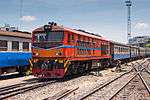 |
First batch of AD24C locomotives. Some refurbished with new MTU 16V4000R41R[26] or Caterpillar diesel engines. |
| AD24C[25] (AHK[23]) | Alsthom,[25] Henschel[25] and Krupp[25] | 4201-4230[23][25] | 1980[25] | 30[25] | 2,400 hp (1.79 MW)[25] | 100[23][25] |  |
Second batch of AD24C, built under license by Henschel and Krupp. Some refurbished with new MTU 16V4000R41R [26] or Caterpillar diesel engines. |
| AD24C[25] (ALD[23]) | Alsthom[25] | 4301-4309[23][25] | 1983[25] | 9[25] | 2,400 hp (1.79 MW) | 100[23][25] | |
Third batch of AD24C. Some refurbished with Caterpillar diesel engines. |
| AD24C[25] (ADD[23]) | Alsthom[25] | 4401-4420[23][25] | 1985[25] | 20[25] | 2,400 hp (1.79 MW)[25] | 100[23][25] | |
Fourth and last batch of AD24C. Some refurbished with new MTU 16V4000R41R[26] or Caterpillar diesel engines. |
| 8FA-36C (HID[23]) | Hitachi | 4501-4522[23] | 1993 | 22 | 2,860 hp (2.13 MW) (1,430 hp (1.07 MW)x2) |
100[23] | .jpg) |
First batch of Main Line Locomotive Program, used MAN B&W Diesel engines in the short-term , then replaced by Cummins KTTA-50L engine, later modified to KTA-50L |
| CM22-7i[22] (GEA[23]) | General Electric | 4523-4560[22][23] | 1995–1996[22] | 38[22] | 2,500 hp (1.86 MW)[22] (1,250 hp (0.93 MW)x2) |
100[23] | |
Second batch of Main Line Locomotive Program, used Cummins KTA-50L[22] engine. Some locomotives air-conditioned. |
| CSR SDA3 | CSR Qishuyan | 5101-5120[27] | 2013–2015[28][29] | 20[28] | 3,190 hp (2.38 MW)[28] | 120 But limited 100[28] | 5101-5110 In Active
5111-5120 Under testing. Use Caterpillar C175-16 ACERT engines[28] |
Diesel hydraulic locomotives
| Type | Manufacturer | Numbers | Year built | Quantity built | Power (horsepower) | Max speed (km/h) | Image | Note |
|---|---|---|---|---|---|---|---|---|
| DH1200BB | Henschel[23] | 3001-3027[23] | 1964 | 27 | 1200[23] | 90[23] | All locomotives except #3015 and 3013 are retired. #3026 preserved. Some sold to Italian-Thai construction and rebuilt by Vossloh, remainder scrapped. | |
| M1500BB | Krupp[23] & Krauss-Maffei | 3101-3130[23] | 1969 | 30 | 1500[23] | 90[23] | |
3118 Inactive 3114 [tel:3121 3113 3114 3121 3113 3114 3121] have been placed into storage. Remainder sold or retired. |
Diesel multiple units
| Type | Manufacturer | Numbers | Year built | Quantity built | Power (horsepower) | Max speed (km/h) | Image | Note |
|---|---|---|---|---|---|---|---|---|
| RHN | Hitachi | 1011-1048 (power cars) 11-48 (trailer cars) |
1967 | 38+38 | 220 | 90 | 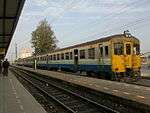 |
Now used as a Northeastern line commuter train. Some installed Nathan K3LA horn. |
| RTS | Tokyu | D9-D16 (power cars) TS4-TS7 (center/trailer cars) |
1971 | 8+4 | 220 | 70 | Ex-Mahachai railways, to be refurbished. Similar bodyshell of THN and NKF but with different formation (power car-2 trailer cars). | |
| THN | Tokyu, Hitachi and Nippon Sharyo | 1101–1140 | 1983 | 40 | 235 | 105 | 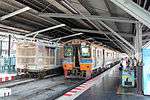 |
Similar to NKF. Some installed Nathan K3LA horn. |
| NKF | Nippon Sharyo, Hitachi, Fuji Heavy Industries,Kawasaki Heavy Industries, Niigata Tekkousho, and Kinki Sharyo | 1201–1264, (center) 2101-2112 | 1985 | 64+12 | 235 | 105 | |
Similar to THN, but with plastic chairs. Some installed Nathan K3LA horn. |
| ASR 158/T |
British Rail Engineering Limited, Derby Works | 2501–2512, (center) 2113-2120 | 1991 | 12+8 | 285 | 160 km/h but Ministry of transport limited the top speed to 120 km/h. |  |
Metre gauge version of British Rail Class 158, with different gangways and couplers, and with inward-opening slam doors instead of plug doors. 3-car set until 2011, when all were refurbished with new seats, vinyl floors, an extra coach, plug doors and new livery. Some installed Nathan K3LA horn. |
| APD .20 | Daewoo Heavy Industries | 2513-2524 (center) 2121-2128 | 1995 | 10+8 | 298 | 120 | |
First batch, narrow body. All units installed Nathan K3LA horn. |
| APD .60 | Daewoo Heavy Industries | 2525-2544 | 1996 | 20+40 | 298 | 120 | |
Second batch, wide body. All units installed Nathan K3LA horn. |
Former types
Diesel hydraulic locomotives
| Type | Manufacturer | Numbers | Year built | Quantity built | Power (horsepower) | Max speed (km/h) | Image | Note |
|---|---|---|---|---|---|---|---|---|
| CR-8b[30] | Plymouth Locomotive Works | 2001-2010[30] | 1963 or 1964[30] | 10[30] | 900[30] | 80[30] | All locomotives withdrawn in 1968 and sent to Vietnam[30] | |
Future railways
High Speed Railways
Thai-Chinese railways
China and Thailand are building a high-speed railway in two phases: Bangkok-Nakhon Ratchasima and Nakhon Ratchasima-Nong Khai. This route's trains will operate at about 250 km/h.[31]
Thai-Japanese railways
Japan will provide Shinkansen technology for a high-speed rail link between Bangkok and the northern city of Chiang Mai.
See also
References
- 1 2 Ganjanakhundee, Supalak (2016-02-10). "Rail plan may serve China's interests more than Thailand's". The Nation.
- 1 2 "Railway of Thailand History". State Railway of Thailand (SRT). Retrieved 14 July 2016.
- ↑ Thongkamkoon, Chaiwat. "Thailand's Railway Development Strategy 2015-2022" (PDF). Railway Technology Development Institute of Thailand. Retrieved 2014-11-28.
- ↑ Chantanusornsiri, Wichit (23 January 2012). "State railway to finally account for assets and liabilities". Bangkok Post.
- ↑ Mahitthirook, Amornrat; Marukatat, Saritdet (22 December 2010). "Getting on track needs strong political will". Bangkok Post.
- ↑ Bowring, Philip (23 October 2009). "Thailand's Railways: Wrong Track". Asia Sentinel. Asia Sentinel. Retrieved 22 August 2012.
- ↑ Mahitthirook, Amornrat (2016-04-05). "SRT eyes rail crossing danger spots". Bangkok Post. Retrieved 5 April 2016.
- ↑ Janssen, Peter (2 November 2016). "Thailand takes a long-term gamble on Isaan region". Nikkei Asian Review. Retrieved 3 November 2016.
- ↑ New Eastern rail line gets on track, The Bangkok Post, 13/01/2012
- ↑ Barrett, Kenneth (2013). "Walk 1 Wong Wian Yai". 22 Walks in Bangkok (ebook sample 36 pp. 2.5MB). Singapore: Tuttle. p. 25. ISBN 978 1 4629 1380 0. Retrieved 2014-07-27.
The Mahachai-Mae Klong line was built by the Tha Cheen Railway Company under a private concession and opened in early 1905, its purpose being to bring fish and farm produce from the coast.
- ↑ "Inaugural train begins Laos royal visit". Railway Gazette International. 2009-03-05.
- ↑ "NEW CHINA-LAOS LINK". Railways Africa. Retrieved 2010-11-09.
- ↑ "STANDARD GAUGE FOR THAILAND". Railways Africa. Retrieved 2010-12-19.
- ↑ "Railway Gazette: Two standard gauge main lines recommended". Retrieved 2011-02-27.
- ↑ "Neighbours to the west get closer | Bangkok Post: news". Bangkok Post. 2012-02-28. Retrieved 2012-08-13.
- ↑ "Commuter line timetable". SRT website. State Railway of Thailand. Retrieved 20 January 2012.
- ↑ ศูนย์ประชาสัมพันธ์และบริการท่องเที่ยว (22 October 2010). การรถไฟแห่งประเทศไทยพัฒนารถไฟสายศิริราช-ศาลายานำร่อง เตรียมสร้างโครงข่าย. press release (in Thai). Retrieved 20 January 2012.
- ↑ "Bangkok Suvarnabhumi airport rail link opens". Railway Gazette International. 2010-08-24.
- 1 2 Transport and Traffic Statistics and Information Thailand
- ↑ Thailand: Transport Sector Assessment, Strategy, and Road Map. ADB, 2011
- ↑ State railway tries mini-containers, 5 Feb 2016
- 1 2 3 4 5 6 7 8 9 10 11 12 Phil's Loco Page (July 4, 2015). "GE Export".
- 1 2 3 4 5 6 7 8 9 10 11 12 13 14 15 16 17 18 19 20 21 22 23 24 25 26 27 28 29 30 "SRT Diesel locomotive". September 6, 2013.
- 1 2 3 4 Dave Dallner (November 20, 2010). "General Electric UM12C Production Roster".
- 1 2 3 4 5 6 7 8 9 10 11 12 13 14 15 16 17 18 19 20 21 22 23 24 25 26 27 28 29 "Locomotives Diesel standard Alsthom".
- 1 2 3 "SRT Alsthom Locomotive for MTU Engine". November 26, 2013.
- ↑ Wisarut (16 January 2015), "New SRT Locos: 20 CSR- 8 locos delivered!", 2Bangkok, retrieved 11 July 2015
- 1 2 3 4 5 "CSR Qishuyan locomotives delivered to Thailand", www.railwaygazette.com, DVV Media Group, 10 January 2015, retrieved 4 July 2015
- ↑ "CSR Qishuyan to supply 20 locomotives to Thailand", Railway Gazette, DVV Media Group, 27 January 2013, retrieved 4 July 2015
- 1 2 3 4 5 6 7 "First D10H/Plymouth CR-8b , Bo-Bo Diesel Hydraulic", Railways in Vietnam (railwaysinvietnam.com), retrieved 11 July 2015
- ↑ "รถไฟความเร็วสูง ไทย-จีน-ญี่ปุ่น". Realist.co.th. Retrieved 25 Mar 2016.
External links
| Wikimedia Commons has media related to State Railway of Thailand. |
- (English) State Railway of Thailand
- (Thai) State Railway of Thailand
- (Thai) Official State Railway of Thailand on Facebook
- (Thai) Official State Railway of Thailand on Twitter
- (Thai) Official State Railway of Thailand on Youtube
- Winchester, Clarence, ed. (1936), "Trains in Siam", Railway Wonders of the World, pp. 1364–1368 illustrated description of the Siamese railways in the 1930s

